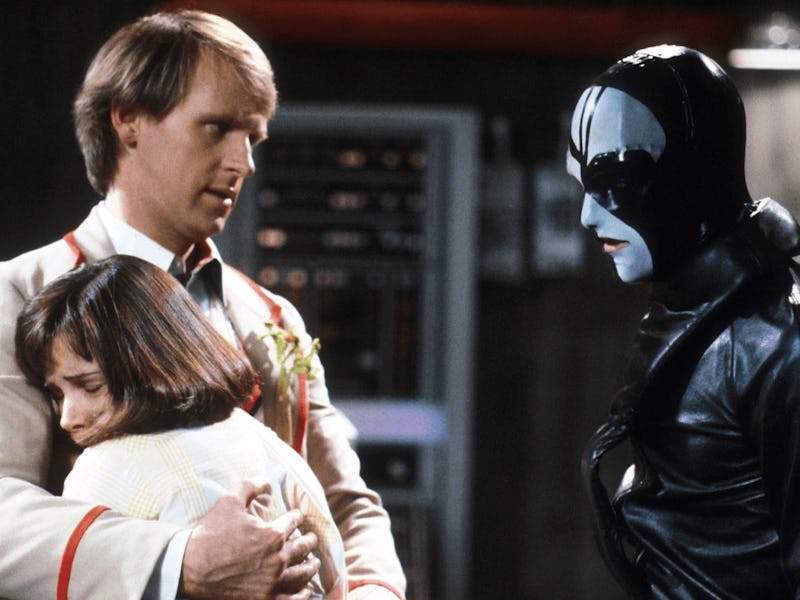The Secret to Doctor Who’s Regenerations Lies in its Classic Era
Thirty-nine years ago, Doctor Who had the courage to underplay itself.

One year ago, Jodie Whittaker stood on a CGI replica of the Durdle Door in Dorset and was absorbed by a burst of light, transforming before our eyes into David Tennant. This is nothing new for Doctor Who fans — by the end of November, David Tennant will have exploded into fiery light/a different person for the third time in his career.
Regenerations are incredibly exciting moments in the Who canon — the diegetic passing-of-the-torch from one actor to another (soon to be Ncuti Gatwa) offers tons of opportunities to reflect back and look forward. But often the dramatic potential of what happens to our supposedly invincible Time Lord protagonist is overlooked: after all, our hero must die for the show to continue.
In fairness, it’s not like the emotional complexity of regeneration has been overlooked in the dozen-plus times the Doctor has done it. Since the show was rebooted in 2005, we’ve seen multiple emotional versions: Christopher Eccleston’s Doctor absorbed the heart of the Time Vortex after almost committing genocide and saving his companion, which felt in a way like his own grief being healed. Tennant’s Doctor sacrificed himself for a semi-regular but cosmically insignificant elderly companion, proving to himself he was the type to lay down his life for anybody. The last moments of Peter Capaldi’s Doctor were spent leaving a goodbye message for a future incarnation that’s delivered, like how his darkest moments as the Doctor were spent, completely alone.
But every regeneration we’ve seen in NuWho has felt deliberately heightened. It’s always romantic and sentimental (as it should be?) but is at least slightly tainted by the tremendous build-up to the Doctor mourning his life and coming to terms with his death. It’s heroic to a fault — Matt Smith’s Doctor’s regeneration, with its sweet, dreamy aesthetics and bombastic Murray Gold score, cranks up the triumphant celebratory vibes to obscene levels. We do lose something by overdoing regenerations like this, something more intimate and nuanced is neglected. Doctor Who should take inspiration from how underplayed the Doctor’s regeneration was played in the Classic Era.
Peter Davison and Nicola Bryant in “The Caves of Androzani,” one of the greatest regeneration stories of Doctor Who.
In the serial “The Caves of Androzani,” the 5th Doctor (Peter Davison) and his companion Peri (Nicola Bryant) are exposed to a subterranean substance known as Spectrox, the life-extending material at the centre of a war between a conglomerate and a heavily scarred, cave-dwelling, leather-clad villain named Sharaz Jek, who feels part-Harkonnen and part-Phantom of the Opera. The Doctor wipes the Spectrox off his hand like it’s your average funky space residue; this exposure will eventually kill him.
“The Caves of Androzani” feels in some ways prophetic of the NuWho era. It trades in a darkness that was uncommon for Davison’s era of the show but would be readily embraced post-reboot, and it was shot in imaginative, cinematic ways that would make a return over 20 years later — to date, “Androzani” director Graeme Harper is the only director to work in both classic and reboot eras of the show.
But there’s a frankness and lack of polish to the 1984 serial that feels refreshing today — the Doctor and his companion spend nearly the whole story suffering, mixed up in an unremarkable but deadly conflict that proves the core tenets of human evil can be found wherever among the stars you visit. The Doctor’s regeneration didn’t come at the hands of iconic baddies the Daleks or his archrival the Master — but from a common biological weakness. At the end of the day, Sharaz is just some guy, one fueled by bitterness, misery, and resentment, and his broken body is left buried in unnavigable caves — even though he subjected the 5th Doctor to the worst distress and desperation he saw during his lifetime.
Davison’s frenzied, bulging eyes when he almost crashes a gunrunner spaceship, or his contorted body in claustrophobic tunnels as he searches for an antidote make it feel like the Doctor isn’t just being physically hurt, but psychologically too. Maybe only a regeneration can repair the damage done to our faultless, dashing hero.
Doctor Who is about to tread some extremely nostalgic ground — understandable for the 60th anniversary of the show, but more worrying for future seasons. With a supercharged Disney+ budget and the return of a fan-favorite showrunner, it’s unlikely David Tennant’s impending regeneration won’t be a pat on the back for all the great Who we’ve seen together.
But what better way to celebrate the show’s longevity than something startlingly dramatic, reminding viewers of how hard the creative team had to work to earn profoundly compelling entertainment? Classic Who’s threadbare style isn’t just a template to freshen up as soon as the budget balloons — the economical necessities pushed the creative team to tap into some intimate, nasty drama. For the sake of Who’s future eras, hopefully the show will remember that visiting the past should inspire what comes next, and isn’t just an excuse to admire the view. Change is the lifeblood of the show, but it should always bring ingenuity too.